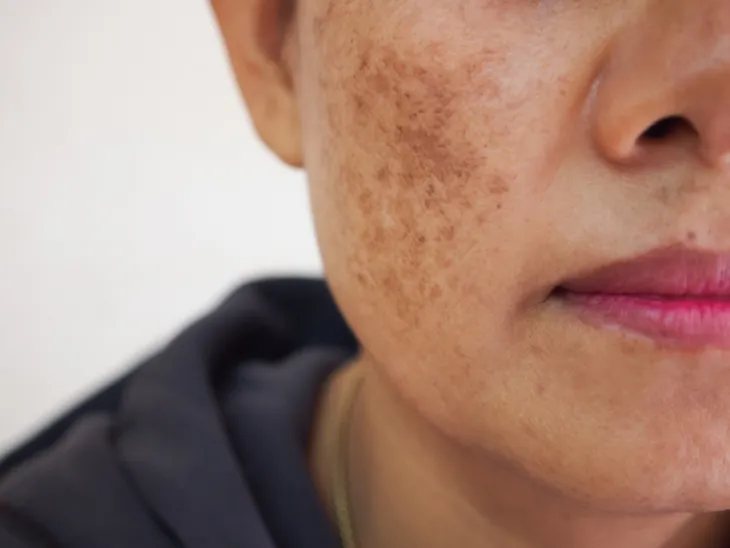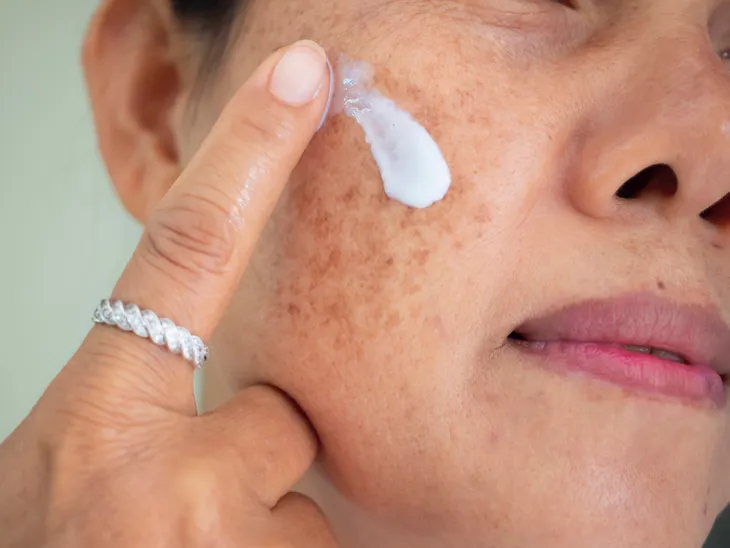- Melasma is a skin condition that causes dark, discolored patches on the skin, most commonly on the face.
- While melasma can affect both men and women, it’s more commonly seen in women.
- For some individuals, melasma can clear up on its own, however, others may require a treatment plan.
Just like the rest of your body, your skin is constantly changing. From sun exposure to hormonal changes and even natural aging wear and tear, the skin can go through a lot. Noticing any new skin spots can be a cause for alarm and your first thought might be skin cancer, but it could also be melasma.
Melasma is a skin condition that causes dark, discolored spots and patches on the skin, most commonly on the face. And it’s more common than you may think! The Cleveland Clinic says 15- to 50-percent of pregnant women develop it and between 1.5- to 30-percent of the population may develop it in their lifetime. It usually starts between 20- and 40-years of age. Follow along as we uncover everything you need to know about melasma, including the common signs, causes, treatment options, and prevention tips.
Common Signs of Melasma
The telltale sign of melasma is patches or spots of discoloration. These patches will be darker than your skin color (usually brown or gray in color) and are usually symmetrical, Healthline points out.
Melasma most commonly develops on the face, usually affecting the cheeks, forehead, bridge of the nose, and chin, however, it can also affect other areas of the body too like your neck or forearms. While melasma doesn’t cause any harm, some individuals feel self-conscious about the patches. Even though melasma is not skin cancer, it can look like other skin conditions so it’s important to see your healthcare provider for a proper diagnosis.
Types of Melasma
Melasma can be categorized into three types depending on the depth of the pigment, explains the Cleveland Clinic. The first is known as epidermal melasma. This type causes dark brown patches with a well-defined border and sometimes responds to treatment.
The second type is known as dermal melasma which causes light brown or bluish patches with blurry borders. The source explains this type doesn’t respond well to treatment. The third type is called mixed melasma which means you have a combination of brown and bluish patches. This is the most common of the three and “shows some response to treatment,” says the source.
What Causes Melasma?
Unfortunately, more research is needed to fully understand what causes melasma. That said, The American Academy of Dermatology Association (AAD) explains that researchers have discovered “that when someone has melasma, the cells that give skin its color (melanocytes) tend to be more active.” However, why this happens in some people, isn’t fully understood.
The source also notes that there are possible factors that may trigger melasma, such as sun exposure, pregnancy, some medications, stress, and thyroid disease. We’ll dive deeper into these triggers later.
Who’s At-Risk for Melasma?
While melasma can affect both men and women, it’s more commonly seen in women. The AAD also points out that women with medium to dark skin tones have a greater risk of developing it.
Melasma is also very common during pregnancy due to the excess of estrogen and progesterone. The source notes melasma may go away after the baby is born.
Other factors that may increase your risk of melasma include sun exposure, hormone treatment, certain skin care products (if they irritate your skin), some medications, and thyroid disease. Genetics may play a role too, meaning if an immediate family member has melasma, you may have an increased risk of developing it too.
Skin Conditions Commonly Confused With Melasma
As mentioned, melasma can sometimes be mistaken for other skin conditions, which is why it’s important to see a health professional for a proper diagnosis. A dermatologist may be able to diagnose melasma through observation but in some cases, a biopsy may be necessary. This involves removing a small piece of your skin to be examined.
The Cleveland Clinic says some common skin conditions that can be confused with melasma include:
- Postinflammatory pigmentation
- Actinic lichen planus and lichen planus
- Lentigo (age spots)
- Nevus of Hori
- Nevus of Ot
- Drug-induced pigmentation
- Guttate hypomelanosis
How Is Melasma Diagnosed?
According to the AAD, dermatologists can often diagnose melasma just by examining your face and neck. To confirm a diagnosis, they may also need to use a device called a Wood’s lamp or dermatoscope to examine your skin
The special device allows your dermatologist to see how deep the darker pigments reach into the layers of your skin. This is important information to know and can influence your treatment plan.
Treating Melasma
For some individuals, melasma can clear up on its own. This is especially common when it’s triggered by pregnancy or hormone therapy. However, others may require a treatment plan to reduce their appearance.
Treatment may include sun protection strategies, medication, creams, and other procedures (which we’ll explain in more detail next). The goal of treatment is to reduce how much pigment your body makes and to even out your skin tone. Keep in mind, the AAD says it may take between 3- to 12-months to see results or it may take longer if you’ve had melasma for a long time.
Treatment: Sun Protection
Sun exposure can darken existing melasma spots and it can make new patches develop. If you’ve been diagnosed with melasma, your dermatologist will likely recommend regular sun protection as part of your treatment plan.
The AAD says a great way to protect your skin from sunlight is by wearing a broad-spectrum sunscreen with SPF 30 or higher. The source also notes that dermatologists often recommend sunscreens that contain zinc oxide, titanium dioxide, and iron oxide. It’s important to reapply throughout the day, especially if you’re spending a lot of time outdoors. You can also protect your skin from the sun by wearing a wide-brimmed hat and staying in the shade whenever possible.
 Shutterstock/New Africa
Shutterstock/New AfricaTreatment: Medication
In some cases, medication may be necessary. The goal of medication is to decrease excess pigment in your skin.
The AAD says there are a variety of medicated creams available but ultimately your dermatologist will determine which one is best for you. Keep in mind, some of these medications may require a prescription. Your dermatologist will provide instructions on how to apply the creams at home and it’s important to follow their directions for the best results.
Other Treatment Options
The AAD points out that sometimes, even when you follow your treatment plan exactly as recommended, melasma still doesn’t go away completely. Luckily there are treatment advances that may help improve your results. The source says the following procedures may be recommended as part of your treatment plan:
- Laser and light treatments
- Platelet-rich plasma
- Chemical peel
- Microneedling
Keep in mind, it’s vital to only receive these procedures from a board-certified dermatologist. These professionals have the right training to determine the best procedure for you and they’re trained to perform it properly and safely.
How to Make Melasma Less Noticeable
While melasma doesn’t always go away completely (even with treatment) the AAD says there are steps you can take to help make it less noticeable. The first step is protecting your skin from sunlight every day, which we discussed earlier. Wearing sunscreen and protecting your skin is really key when outdoors.
Another way you can make melasma less noticeable is by using gentle and fragrance-free skincare products. The source says a good rule of thumb to follow is if the skin care product stings or burns your skin, it’s irritating your skin and should be avoided. Skin products that cause irritation may darken your spots. You should also avoid waxing the areas of your skin that have melasma as this can cause inflammation and make your melasma worse.
Finally, you can also hide melasma by using makeup, however, the source says there is a particular order you should follow. The AAD says you should first apply your melasma medication then sunscreen and then your makeup to get the best results.
Can Melasma Be Prevented?
Unfortunately, the Cleveland Clinic says there is no surefire way to prevent melasma entirely. It’s not possible to avoid genetics or stop the skin condition when you’re pregnant but you may be able to prevent it from becoming worse by protecting your skin from the sun and following your treatment plan.
The source also notes that a skin-friendly diet may also help. This may include eating foods rich in vitamin D, such as eggs, meat, milk, almond milk, mushrooms, oily fish, orange juice, and yogurt. You should also discuss prevention steps with your dermatologist.
 Shutterstock/New Africa
Shutterstock/New Africa












